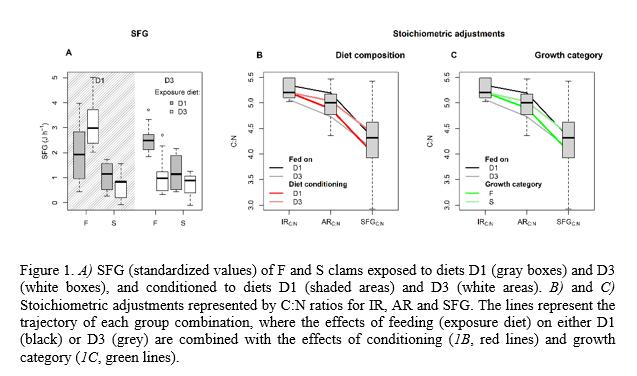HIGH LIPID CONTENT DIETS ENHANCE GROWTH AND IMPROVE ELEMENTAL STOICHIOMETRIC ADJUSTMENTS IN Ruditapes decussatus
Introduction
Two variables are crucial in the intensive production of marine bivalves: the biochemical composition (BC) of food supplied together with the occurrence of large inter-individual differences in growth performance of endogenous origin. Quantitative knowledge of the effects of these variables and their interactions is of great interest for hatchery management, providing both useful information for the formulation of optimal diets and criteria for the eventual selection of high performance lines. Regarding BC, the effects of variable proportions of lipid to carbohydrate in the diet has been extensively studied (mainly in clams) in the search for non-phytoplanktonic supplements that can reduce phytoplankton production costs in bivalve rearing (Laing, 1987; Albentosa et al., 2002; Mamat & Alfaro, 2014). The present study investigates the effects of mixed diets with varying lipid/carbohydrate ratios on a) the growth and physiological performance and b) the elemental (C, N) composition and stoichiometric balances in fast- and slow-growing phenotypes of juvenile carpet shell clams (Ruditapes decussatus), focusing on homeostatic nutrient regulation, stoichiometric adjustments, and biochemical composition of body tissues.
Materials and methods
Juvenile clams from the same cohort were segregated into fast (F) and slow (S) growing groups. They were subjected to a controlled diet comprising varying lipid/carbohydrate ratios, with constant C:N ratios. The composition of the diet differed according to the proportions of the microalga Rhodomonas lens and the yeast Saccharomyces cerevisiae (D1: 80% - 20%; D2: 50% - 50%; and D3: 20% 80%, respectively). Physiological parameters such as clearance rate, absorption efficiency, ammonium excretion rate and metabolic rate were measured to determine the scope for growth (SFG). These parameters were then utilised to calculate elemental balances (C and N) by means of analysis of their C and N contents in food and faeces. Finally, the clams were freeze-dried in order to ascertain their biochemical composition by means of conventional colorimetric procedures (see Arranz et al., 2021).
Results
Dietary effects: Lipid-rich diets significantly enhanced SFG (Figure 1A) and elemental balances in juvenile clams. Clams conditioned to lipid-rich diets exhibited higher energy balances compared to those fed carbohydrate-rich diets. The biochemical composition of body tissues reflected the dietary content, indicating limited ability for homeostatic compensation. However, F clams showed a higher degree of tissues homeostasis.
Phenotypic differences: Fast-growing clams (F) showed greater phenotypic plasticity compared to slow-growing clams (S). This plasticity allowed fast-growing clams to better manage nutritional limitations imposed by different diets. For instance, fast-growing clams increased their clearance rates by 25% when fed carbohydrate-rich diets, compensating for the lower energy content (Figure 1A). In contrast, slow-growing clams exhibited only a 10% increase in clearance rates under the same conditions, indicating a lower capacity for compensatory feeding.
Stoichiometric Adjustments: Stoichiometric adjustments (Figure 1B and 1C) were primarily post-absorptive, with significant differences observed between diets and growth phenotypes. Fast-growing clams maintained a more stable C:N ratio (around 4.0) in their tissues across different diets, suggesting efficient nutrient regulation, while slow-growing clams exhibited a wider range of C:N ratios (3.8 to 4.5).
Discussion and conclusion
Conditioning to a high lipid content diet enhanced physiological compensations, allowing juvenile clams to face acute nutritional deficits. In contrast, the low lipid content diet reduced digestibility and impaired lipid balances. Lipid-rich diets significantly improved growth performance, especially in fast-growing phenotypes, highlighting the endogenous origin of growth differences. Fast growers achieved better physiological status under high-quality diets, enabling effective compensation for acute changes. Slow growers showed higher nitrogen release, indicating less efficient protein turnover. Stoichiometric regulation involved changes in absorption patterns and postabsorptive regulation.
The enhanced growth rates and stoichiometric balances observed in clams fed lipid-rich diets highlight the importance of dietary lipid content for optimizing growth and physiological efficiency in bivalve aquaculture. Given the greater phenotypic plasticity and together with their higher degree of tissues homeostasis, the selection of fast-growing lines allows them to be more resilient to nutritional variations. However, replacing more than 50% of microalgal diets with inert diets can compromise growth and disrupt lipid and protein balances.
References
Albentosa, M., Pérez-Camacho, A., Fernández-Reiriz, M.J., Labarta, U., 2002. Wheatgerm flour in diets for Manila clam, Ruditapes philippinarum, spat. Aquaculture 212, 335–345. https://doi.org/10.1016/S0044-8486(02)00121-7.
Arranz, K., Urrutxurtu, I., Prieto, D., Ibarrola, I., Urrutia, M.B., Navarro, E., 2020. Methods for assessment of body tissue composition as an indication of the energetic status in bivalve populations: A comparison of biochemical and elemental analysis. Ecol. Indic. 121, 107074. https://doi.org/10.1016/j.ecolind.2020.107074.
Laing, I., 1987. The use of artificial diets in rearing bivalve spat. Aquaculture 65, 243–249.
Mamat, N.Z., Alfaro, A.C., 2014. Evaluation of microalgal and formulated diets for the culture of the New Zealand pipi clam Paphies australis. Int. Aquat. Res. 6, 2.
